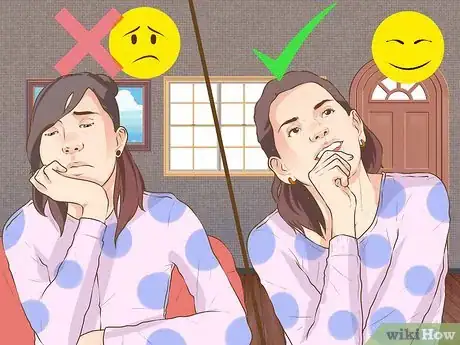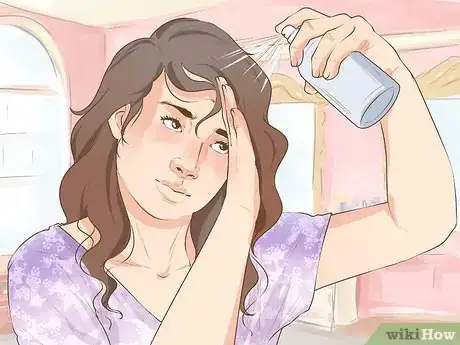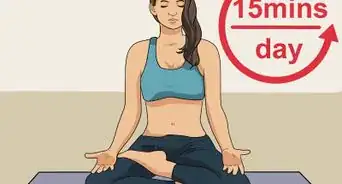This article was co-authored by Leah Morris. Leah Morris is a Life and Relationship Transition coach and the owner of Life Remade, a holistic personal coaching service. With over three years as a professional coach, she specializes in guiding people as they move through both short-term and long-term life transitions. Leah holds a BA in Organizational Communication from California State University, Chico and is a certified Transformational Life Coach through the Southwest Institute for Healing Arts.
There are 21 references cited in this article, which can be found at the bottom of the page.
This article has been viewed 56,538 times.
Did you know that only 4% of women between the ages of 18 and 29 would actually describe themselves as “beautiful"? Whereas 60% of women prefer to describe themselves as either “average” or “natural.” This can, unfortunately, be partially attributed to media and popular culture, which can cause women to feel there is an unrealistic standard of beauty that may be impossible to achieve. Thankfully, beauty doesn’t have to be dictated to you, you can define it for yourself. In fact, many women “feel” beautiful because of other factors, like: being loved, taking care of themselves, having close friends, being in a relationship, and more. In truth, beauty isn’t about how you look, it’s about who you are as a person.[1]
Steps
Showing Off Your Beauty
-
1Smile. There’s a saying - “Smile and the world smiles with you.” It’s great advice. It’s even better advice when you realize that smiling can actually change the chemical reactions in your brain[2] - in a good way. Smiling when you’re unhappy can actually make you feel good. Even if you don’t feel like smiling, give it a try anyway. Yes, you might have to start by faking a smile, but before you know it, it will become a real smile. It also doesn’t hurt to laugh. Laughing increases the oxygen levels to your brain, which in turn releases chemicals called endorphins. Endorphins are good chemicals that make us feel awesome.
-
2Stay healthy. Keep yourself as healthy as possibly by eating properly, getting enough sleep every night, and exercising regularly. But at the same time, don’t beat yourself up if you miss a day or two - you are allowed to have a break. Keeping yourself healthy also includes managing your stress levels. Keeping the stress in your life as low as possible will lead to many other healthy side effects, and you’ll find yourself in a better mood more often.[3]
- Take a moment for yourself, and yourself alone, every day.
- Consider getting massages, pedicures, etc., whatever makes you feel relaxed, on a regular basis.
- Don’t use a scale. Sometimes seeing a number on a scale can have a massive emotional impact on us, yet that number doesn’t necessarily relate to how we feel or what we think of ourselves. Don’t set yourself up for disappointment.[4]
Advertisement -
3Have a positive self-image. Self-image is the mental image you have of yourself. It’s directly related to self-esteem and self-confidence. Your self-image is built-up over time based on your personal life experiences. If your experiences have been mainly positive, you’ll most likely have a positive self-image, and vice versa. If you’ve had negative experience, and therefore a negative self image, you’re more likely to doubt your abilities. Having a positive self-evaluation leads to empathy skills and feelings of contentment.[5]
- Sit down and make a list of all your positive qualities and abilities.[6] You may surprise yourself as to how accomplished you are, and how proud you should feel.[7]
- Try not to compare yourself to other people, whether they’re celebrities, friends or family members. You are not them, so there’s no need to compare yourself to them. You are your own person and comparisons are not required.
- Learn to love you self - as you are. You’re unique and that’s awesome! No matter what you’ve experienced in your life, it’s been a long and difficult journey and you survived.
-
4Get an awesome haircut. It’s amazing how much you hair can impact every thing you do! If you have a haircut you really like, it’s easier to feel confident and happy. If you don’t like your haircut, it can really bring you down and annoy you. The next time you go for a haircut, take a moment to plan ahead to ensure you get the best possible haircut for your needs and wants.[8]
- Go through a list of questions with yourself about your hair, then base your haircut request on your answers:
- Do you need to be able to tie your hair back?
- How much time do you have to ‘do’ your hair each morning?
- What styling tools (blow dryer, flat iron, etc.) do you have and know how to use?
- Google hair styles and review the images. If you see something that matches what you’re hoping to get, print it out and bring it with you. This works really well if you’re looking to get your hair coloured. It’ll save you trying to describe the shade of colour you want in words.
- Provide as much detail as possible to the stylist before they start. Explain exactly what you want and what you need to do with your hair.
- During or after your haircut, ask your stylist for advice on how to style your hair properly. You may not be able to do it exactly the same way they can, but they can teach you several tricks.
- Go through a list of questions with yourself about your hair, then base your haircut request on your answers:
-
5Change up your wardrobe. If you look confident, you’ll feel confident. But that means you have to wear your clothes, and not let them wear you. When trying to dress confidently, you want to make sure you’re using colours and styles that match your personality and your figure. You want to dress to express your personal style, not the style of others. Most importantly, you want to feel comfortable in the clothes you wear.
- Accentuate your best ‘assets’, as opposed to focusing on hiding the things you don’t like about yourself.
- Wear something that you’ll be known for - like a trademark. Maybe that’s always having really awesome earrings, or always wearing bright coloured shoes. Whatever works for you.
- If you’re not sure where to start, consider making an appointment with a personal shopper at your local mall. They can help you sort through the bazillion options available and choose which ones work for you.
-
6Stand up straight. And stop slouching! Easier said than done unfortunately! Good posture equates to muscles that are balanced and aligned properly. Bad posture equates to muscles that ache and are painful. Good posture also affects your joints and can help prevent arthritis. In addition to all the physical benefits of good posture, it can also make you appear confident and ready to take on the world![9] [10]
- Standing - keep your shoulders back and relaxed; pull in your abdomen; keep your feet hip distance apart; balance your weight evenly on both of your feet; and let your hands hang naturally at your sides. Avoid tilting your head in any direction, or locking your knees.[11]
- Sitting - make sure both of your feet can rest comfortably on the ground while your knees are level with your hips; sit back in the chair; put a rolled towel or pillow behind your lower back (if the chair doesn’t have lumbar support); pull your head towards the ceiling; tuck your chin in a little; keep your upper back and neck in a straight line; and relax your shoulders.[12]
- Sleeping - maintain a position that keeps your back curved naturally; try to avoid sleeping on your stomach; firmer mattresses are better than soft mattresses; and if you sleep on your side, put a pillow between your knees to keep your upper leg aligned with your spine.[13]
- Lift with your knees, not your back. When you’re lifting something heavy, keep your back straight and bend your knees. When you stand up, straighten your knees. Don’t bend forward at the waist to pick something up.
Presenting Your Confidence
-
1Think about what your body language is saying. Your body language can sometimes say more than your words. Most of the time body language is determined by how you feel, rather than what you want to portray. But you can change that by simply paying attention to the position of your body while you’re having a conversation. There are specific ways you can adjust your body to convey confidence, they are:[14]
- Don’t fidget. Stand in one spot, with your feet planted on the ground hip-width apart. Stand evenly on both feet, don’t shift from one foot to another.
- Lean back in your chair when you’re sitting. Don’t fidget your lower body. If you need to cross your legs, do so comfortably and loosely. Keep you hands in a relaxed position.
- Look in one spot, or one general area. Keep your head still. Hold you head upwards, with your chin level to the ground.
- Hold your hands together in front or behind you when not using them. If you grip your hands together, do so lightly. But don’t hide your hands in your pockets and don’t put grip your hand in a fist.
- Don’t rush. Walk steadily. Talk steadily as well, don’t rush to get your words out. Confident people are not in a hurry.
- Pause every now and again - whether walking or talking.
- Be comfortable and don’t fidget when there’s a break in the conversation or everyone goes silent.
- Be assertive. Smile. Look people in the eyes. If you’re shaking someone’s hand, do so firmly.
-
2Respect and be kind to others. To truly see that beauty is on the inside, you have to see it in yourself AND in everyone else. Every individual has one or more awesome qualities that make them special. When you’re with other people, look at them with new eyes and see the person they really are - on the inside. By seeing these qualities in others, you’ll start to notice them in yourself.[15]
- Use this opportunity to explore the specific qualities you admire in others, and how you can work to achieve them yourself. Select role models for yourself based on these qualities.
- Don’t be afraid to tell other people what you admire about them. Nothing boosts confidence and self-esteem better than compliments from people who admire you.
-
3Be assertive. Being assertive helps ensure you get what you need out of life. It’s not about controlling other people. Being assertive includes: saying no; stating an opinion; asking for a favour; complimenting someone; and not bowing down to pressure. Being an assertive communicator means you’re able to express yourself openly and honestly, while still respecting the people you’re communicating with. Expressing assertiveness is a great way to boost self-confidence, you’ll feel good after being able to get what you need without anyone being upset or mad.[16]
- When speaking assertively to someone else, remember to: look at them without staring them down; keep the volume of your voice normal, and your tone respectful; don’t use distracting hand gestures; and respect the other person’s personal space.
- Translate your feelings into “I” statements. “I” statements consist of four parts: the feeling, the behaviour, the effect, and the preference - "I feel xxx when xxx because xxx. I’d prefer xxx.” For example, "I feel annoyed when you tell me what to do in emails because it makes me feel disrespected. I’d prefer you ask me to do something rather than tell me to do something.”
-
4Prepare yourself in advance. Remember that you can’t change the past, and you can’t control the future. But you can prepare for future events by looking at what items are under your control and creating an action plan. When creating your plan, avoid the extreme approach where you attempt to take into account every possible outcome. There’s no way you can prepare yourself for all that, so stick to a couple realistic outcomes. Once you’ve come up with your small list of potential outcomes, prioritize them. Work on the items with the highest priority first. And don't think you have to prepare alone. Use your friends and family to help you. Talk through your thoughts with someone, or practice what you’re going to say.[17]
- Preparing yourself in advance can also include saying no. Don’t feel obligated to do something simply because someone asked. If you cannot realistically accomplish what they’re asking, say no.
- After the event or situation has happened, reward yourself for a job well done.
Believing in Yourself
-
1Stop being self-critical. Value and respect yourself. It’s not necessary to be a perfectionist. It’s okay if not everyone likes you. It’s okay if you’re not perfect at absolutely every activity you take up. Your personal value has nothing to do with the things you achieve or don’t achieve. You have value and are worthy no matter what you do, or don’t do. It’s not necessary to take on an “all or nothing” attitude about life.[18]
- Change your vocabulary and stop using the word “should.” “Should” implies a level of perfectionism that isn’t necessary, and can sometimes enforce the unnecessary and useless expectations of others.
- Replace the critical thoughts you have about yourself with encouraging thoughts. Give yourself constructive criticism that can help you make a positive change.[19]
- Don’t feel the need to take responsibility for everything. Not only does it increase your stress levels and overwhelm you, you take away the opportunity for others to be responsible for something (including themselves).
- If something was in your control, and you made a mistake, take the blame. However, if something was out of your control, there’s no need for you to take the blame or feel guilty about it.
-
2Think positively. Not only is being positive important for you, it’s important for the people around you. Young adults listen to what older adults say, and if they hear you talking negatively about yourself (e.g. my butt is fat), may become self-critical as well. Many of these comments are spoken so often we forget we’re actually saying them. So the next time you feel a negative comment coming on, consciously try to change it to a positive comment. You won’t change overnight, and there will be some days when it may feel impossible to think positively, but start small. The important thing is that you realize when you’re being negative and to do something about it.[20]
- Look at yourself in the mirror at least once a day and make a positive comment about yourself.[21]
- Don’t just think about the positive comments, say them. If you like the way your new hair cut looks, say so!
-
3Do not stop learning. Consider this an opportunity to challenge yourself. Learn something new every day. Enrol in courses that teach you something new and exciting, like: drawing, painting, cooking, singing, pottery, etc. Or enrol in college or university courses in subjects that have always interested you, but you haven’t previously had the time to take. Expand your horizons. Encourage a friend to join you in one of your ‘learning expeditions’.[22]
- Take risks. Don’t look at every new learning opportunity as something that must either be won or lost, or perfected. Understand ahead of time that it’s okay if you suck at something, because you can still have fun. But unless you take a walk outside your comfort zone and take a small risk, you may never know how fun it is to learn something new without any expectations.[23]
-
4Work towards your own definition of success. Success in your life isn’t dependent upon other people, it’s depends on what YOU want. Success doesn’t have to be a pre-defined “standard” like the American Dream. Your success should be based on realistic goals that you have for yourself, based on your own wants and needs. Success also doesn’t have to mean perfection, it can include many goals that you can achieve at a level other than perfection. And success doesn’t have to be an end goal, it can be the journey. If you attempted something (e.g. knitting a scarf) and weren’t able to figure it out (e.g. it looked more like a pile of yarn), that’s okay! If you had fun trying, that’s what’s important.[24]
-
5Treat your mistakes as learning experiences.[25] No matter what you attempt to do in life, chances are you’ll make a mistake at some point. Everyone does. First off, there’s absolutely nothing wrong with making a mistake. Some historical mistakes have actually changed the world (e.g. teflon, vulcanized rubber, post-it notes, penicillin). Instead of stressing over the fact that you made a mistake, use it as an opportunity to learn. Think about what you could have done differently. The more mistakes you make, the more you learn and the smarter you become![26]
Expert Q&A
-
QuestionHow do you present yourself as more confident?
 Leah MorrisLeah Morris is a Life and Relationship Transition coach and the owner of Life Remade, a holistic personal coaching service. With over three years as a professional coach, she specializes in guiding people as they move through both short-term and long-term life transitions. Leah holds a BA in Organizational Communication from California State University, Chico and is a certified Transformational Life Coach through the Southwest Institute for Healing Arts.
Leah MorrisLeah Morris is a Life and Relationship Transition coach and the owner of Life Remade, a holistic personal coaching service. With over three years as a professional coach, she specializes in guiding people as they move through both short-term and long-term life transitions. Leah holds a BA in Organizational Communication from California State University, Chico and is a certified Transformational Life Coach through the Southwest Institute for Healing Arts.
Life Coach Standing up straight with your shoulders back and your head up will make you appear more confident. To help yourself feel more confident on the inside, try saying positive affirmations or asking a friend what your positive qualities are.
Standing up straight with your shoulders back and your head up will make you appear more confident. To help yourself feel more confident on the inside, try saying positive affirmations or asking a friend what your positive qualities are. -
QuestionHow do I stay positive about myself?
 Leah MorrisLeah Morris is a Life and Relationship Transition coach and the owner of Life Remade, a holistic personal coaching service. With over three years as a professional coach, she specializes in guiding people as they move through both short-term and long-term life transitions. Leah holds a BA in Organizational Communication from California State University, Chico and is a certified Transformational Life Coach through the Southwest Institute for Healing Arts.
Leah MorrisLeah Morris is a Life and Relationship Transition coach and the owner of Life Remade, a holistic personal coaching service. With over three years as a professional coach, she specializes in guiding people as they move through both short-term and long-term life transitions. Leah holds a BA in Organizational Communication from California State University, Chico and is a certified Transformational Life Coach through the Southwest Institute for Healing Arts.
Life Coach Make a habit of giving yourself a compliment at least once every day. Stand in front of a mirror, and say something nice about yourself.
Make a habit of giving yourself a compliment at least once every day. Stand in front of a mirror, and say something nice about yourself.
References
- ↑ http://www.clubofamsterdam.com/contentarticles/52%20Beauty/dove_white_paper_final.pdf
- ↑ http://www.scientificamerican.com/article/smile-it-could-make-you-happier/
- ↑ https://www.psychologytoday.com/blog/hide-and-seek/201205/building-confidence-and-self-esteem
- ↑ http://www.brown.edu/Student_Services/Health_Services/Health_Education/nutrition_&_eating_concerns/body_image.php
- ↑ http://web.mit.edu/curhan/www/docs/Articles/biases/Taylor_Brown_Illusion_and_Well-Being.pdf
- ↑ Leah Morris. Life Coach. Expert Interview. 19 June 2020.
- ↑ http://my.clevelandclinic.org/health/healthy_living/hic_Stress_Management_and_Emotional_Health/hic_Fostering_a_Positive_Self-Image
- ↑ http://www.womenshealthmag.com/beauty/best-haircut-ever
- ↑ http://www.mayoclinic.org/healthy-lifestyle/adult-health/multimedia/back-pain/sls-20076817?s=1
- ↑ http://www.mayoclinic.org/healthy-lifestyle/adult-health/multimedia/back-pain/sls-20076817?s=2
- ↑ http://www.mayoclinic.org/healthy-lifestyle/adult-health/multimedia/back-pain/sls-20076817?s=3
- ↑ http://www.mayoclinic.org/healthy-lifestyle/adult-health/multimedia/back-pain/sls-20076817?s=5
- ↑ https://my.clevelandclinic.org/health/ns_overview/hic_Posture_for_a_Healthy_Back
- ↑ http://changingminds.org/techniques/body/confident_body.htm
- ↑ http://selfesteem.dove.ca/en/Articles/Written/Help_your_daughter_to_uncover_her_inner_beauty.aspx
- ↑ https://cloudfront.ualberta.ca/-/media/ualberta/students/university-wellness-services/ccs/handouts/english/assertiveness.pdf
- ↑ http://psychcentral.com/blog/archives/2012/02/23/tips-to-help-better-cope-with-stress/
- ↑ http://counselingcenter.illinois.edu/brochures/self-confidence
- ↑ http://www.mtstcil.org/skills/image-3.html
- ↑ http://selfesteem.dove.ca/en/Articles/Written/How_to_build_self-confidence_and_self-esteem.aspx?gclid=CPOC28Ch-scCFQEaaQodokwGdg&gclsrc=aw.ds
- ↑ Leah Morris. Life Coach. Expert Interview. 19 June 2020.
- ↑ https://www.psychologytoday.com/blog/hide-and-seek/201205/building-confidence-and-self-esteem
- ↑ http://counselingcenter.illinois.edu/brochures/self-confidence
- ↑ http://counselingcenter.illinois.edu/brochures/perfectionism
- ↑ Leah Morris. Life Coach. Expert Interview. 19 June 2020.
- ↑ http://counselingcenter.illinois.edu/brochures/perfectionism
About This Article
The best way to present yourself as beautiful and confident is to build a positive self-image, since loving yourself is the best way to be confident and, by extension, be beautiful! If you aren't sure where to start, try making a list of your strengths, and include any details that make you proud of who you are, even if they feel small. Or, if you're having a hard time coming up with a list, ask a loved one to help you. Then, read over your list on a regular basis, and give yourself time to feel proud of everything you have achieved. This will help you accept yourself as you are, without comparing yourself to others. You can further build your self-esteem by looking at yourself in the mirror once a day and make a positive comment about yourself out loud. For example, if you like the way your new haircut looks, say so! For tips on how to use your body language to exude confidence, read on!









































































